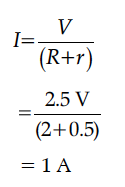A capacitor of 4 μF is connected as shown in the circuit Figure. The internal resistance of the battery is 0.5 Ω. The amount of charge on the capacitor plates will be :

(a) 0 μC
(b) 4 μC
(c) 16 μC
(d) 8 μC

(a) 0 μC
(b) 4 μC
(c) 16 μC
(d) 8 μC
(d) Explanation : As capacitor offer infinite resistance for DC circuit. So current from cell will not flow across branch of 4 μF and 10 Ω. So current will flow across 2 ohm branch.
So current flows through across 2 Ω resistance from left to right is,

So Potential Difference (PD) across 2 Ω resistance V = RI = 2×1 = 2 Volt
As battery, capacitor and 2 branches are in parallel. So PD will remain same across all three branches. As current does not flow through capacitor branch so no potential drop will be across 10 Ω.
So PD across 4 F capacitor = 2 Volt
Q = CV = 2 μF× 2 V = 8 μC
So current flows through across 2 Ω resistance from left to right is,

So Potential Difference (PD) across 2 Ω resistance V = RI = 2×1 = 2 Volt
As battery, capacitor and 2 branches are in parallel. So PD will remain same across all three branches. As current does not flow through capacitor branch so no potential drop will be across 10 Ω.
So PD across 4 F capacitor = 2 Volt
Q = CV = 2 μF× 2 V = 8 μC
Two capacitors of 3 μF and 6 μF are connected in series with a battery of P.d. 12 V. The P.d. across 3μF and 6μF capacitors respectively will be :
(a) 8 V, 4 V
(b) 6 V, 6 V
(c) 4 V, 8 V
(d) 9 V, 3 V
Three capacitors of 6μf each are connected across a triangle. What is the resultant capacitance across any side of the triangle.
1. 6 μf
2. 2 μf
3. 4 μf
4. 12μf
Two capacitors of capacitance 6 µF and 4 µF are put in series across a 120 V battery. What is the potential difference across the 4 µF capacitor?
(a) 72 V
(b) 60 V
(c) 48 V
(d) zero
The amount of work required to increase the distance between -6µC and 4µC from 6 cm to 18 cm will be :
(a) 1.8 J
(b) 2.4 J
(c) 1.8 µJ
(d) 2.4 µJ
Three capacitors 3 μF, 6 μF and 6 μF are connected in series to a source of 120 volt. The potential difference across the 3 μF capacitor will be
(a) 40 volt
(b) 30 volt
(c) 40 volt
(d) 60 volt
The capacitance of earth, viewed as a spherical conductor of radius 6408 km is:
(a) 1420 μF
(b) 712 μF
(c) 680 μF
(d) 540 μF
Minimum number of capacitor of 2μF each required to obtain a capacitance of 5μF will be:
(a) 4
(b) 3
(c) 5
(d) 6
How does one explain increase in resistivity of a metal with increase in temperature ?
Two dipoles, made from charges ± q and ± Q respectively, have equal dipole moments. Give the
(i) ratio between the ‘separations’ of these two pairs of charges,
(ii) angle between the dipole axes of these two dipoles.
Graph showing the variation of current versus voltage for a material GaAs is shown in the figure, identify the region of :
The emf of a cell is always greater than its terminal voltage. Why ? Give reason.
An electron is accelerated through a potential difference V. Write the expression for its final speed, if it was initially at rest.
Why should electrostatic field be zero inside a conductor ?
Why must electrostatic field at the surface of a charged conductor be normal to the surface at every point ? Give reason.
